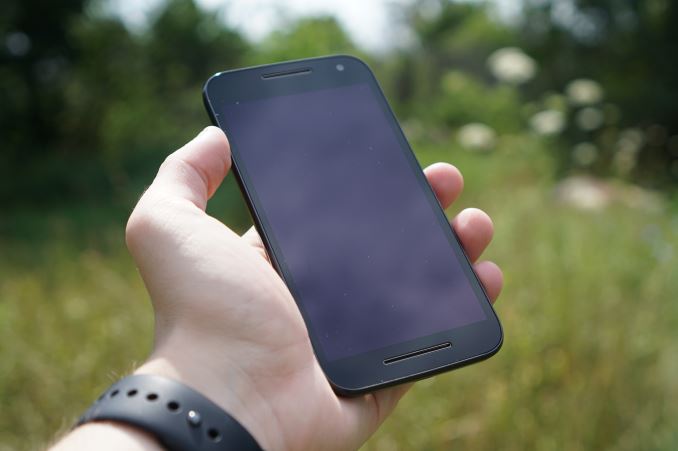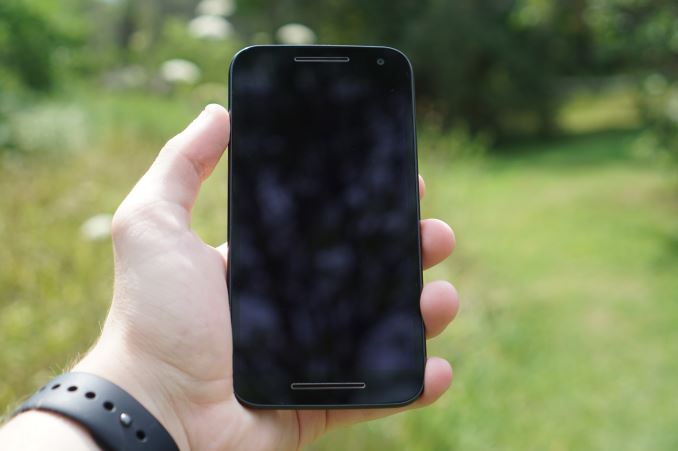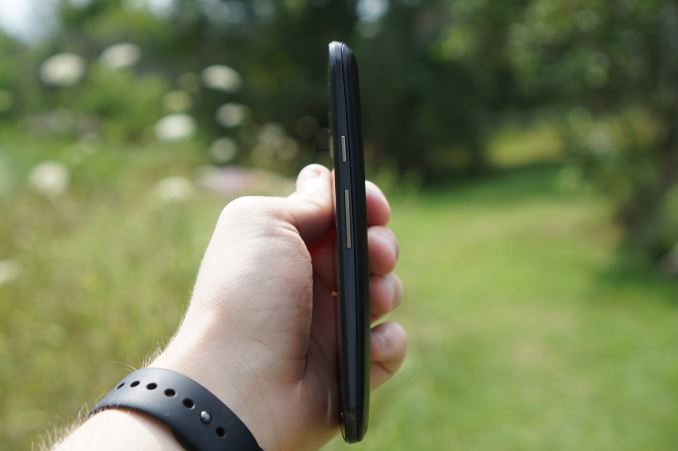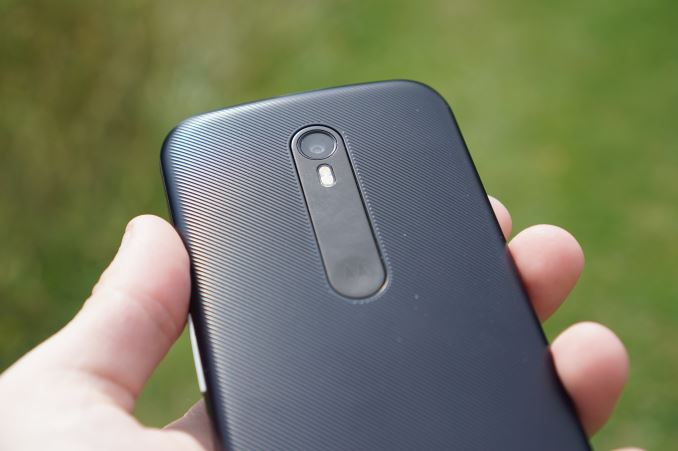The Moto G (2015) Review
by Brandon Chester on August 19, 2015 8:00 AM EST- Posted in
- Smartphones
- Mobile

Motorola's original Moto G was one of the first Android devices to offer what one could honestly call a good user experience at a price of around $200. It had a 4.5" 720p display, Qualcomm's Snapdragon 400 SoC, a 5MP rear camera, 1GB of RAM, and 8GB of memory. Since that time, Motorola has adopted a structure where their Moto E fills in the sub $150 range, the Moto G hovers around $200, and the Moto X acts as a several hundred dollar flagship device, although the dual Moto X launch for 2015 changes this slightly. In early 2014 we saw Motorola refresh the Moto G with support for LTE, and later in the year they did a more major refresh which bumped the display size to 5", the camera resolution to 8MP, and added the microSD slot from the LTE model of the original version.
While Motorola's 2014 refresh of the Moto G was technically a major update as far as their yearly cadence was concerned, many aspects of the phone remained the same. There was no change to the SoC or the amount of RAM, no change to the display resolution or connectivity, and no change to battery capacity. The early 2015 launch of the Moto E made things even stranger, as it shipped with some specifications that actually outclassed the Moto G, such as Qualcomm's Snapdragon 410 SoC. This put Motorola in a strange situation, which has finally been resolved with the new 2015 model of the Moto G. In my view, this is the first truly major update that the phone has seen since the original version, and you can see what improvements Motorola has made in the chart below.
| Moto G (2014) | Moto G (2015) | |
| SoC | Snapdragon 400 1.2 GHZ A7 | Snapdragon 410 1.4 GHz A53 |
| RAM | 1GB | 1/2GB |
| NAND | 8GB NAND + microSD | 8/16GB NAND + microSD |
| Display | 5” 720p IPS |
5” 720p IPS |
| Network | 2G / 3G / 4G LTE | 2G / 3G / 4G LTE (Category 4 LTE) |
| Dimensions | 141.5 x 70.7 x 11mm, 149g | 142.1 x 72.4 x 6.1-11.6mm, 155g |
| Camera | 8MP Rear Facing (Sony IMX179) f/2.4, 1.4 micron 1/3.2" sensor | 13MP Rear Facing (Sony IMX214) f/2.0, 1.1 micron 1/3.06" sensor |
| 2MP Front Facing | 5MP Front Facing | |
| Battery | 2070 mAh (7.87 Whr) | 2470 mAh (9.39 Whr) |
| OS | Android 4.4 (At Launch) | Android 5.1 (At Launch) |
| Connectivity | 2.4 GHz 802.11b/g/n + BT 4.0, USB2.0, GPS/GNSS |
2.4 GHz 802.11b/g/n + BT 4.0, USB2.0, GPS/GNSS |
| SIM | MicroSIM | MicroSIM |
| Launch Price | $179 (1GB/8GB) | $179 (1GB/8GB) $219 (2GB/16GB) |
As you can see above, this year's iteration of the Moto G brings along some significant improvements. For the first time ever, we're seeing an update to the Moto G's SoC. While both the first and second generation models used Qualcomm's Snapdragon 400 SoC with four 1.2GHz Cortex A7 cores, this year's model adopts a 1.4GHz version of Snapdragon 410 with four Cortex A53 cores. The battery also receives a hefty bump in capacity, although this does come along with an increase in height, width, and thickness, as well as a slight increase in mass. Memory remains the same for the base model at 8GB of NAND and 1GB of RAM, but an extra $40 bumps that to 16GB of NAND and 2GB of RAM.
The rear-facing camera moves from Sony's IMX179 sensor to IMX214 which interestingly enough is the same improvement that was made going from the Nexus 5 to the Nexus 6. The sensor size increases from 1/3.2" to 1/3.06", and the resolution is bumped to 13MP from 8MP. This means that pixel size drops from 1.3 micron to 1.12, and low light scenarios may see a reduction in image quality as a result, but the wider F/2.0 aperture can help to offset this. The front-facing camera also jumps from a 2MP to a 5MP sensor.
Connectivity and the display don't see any improvements with this upgrade. We're still looking at a 5" 1280x720 IPS display, and with WiFi and Bluetooth you get 2.4GHz 802.11n and Bluetooth 4.0 LE.
Design
At this point, Motorola's industrial design is fairly well known and understood. All of their devices, from the Moto E all the way up to the Nexus 6, have essentially the same chassis shape with differing dimensions. The big difference between Motorola's devices is the materials that are used. While Moto Maker allows users to customize their devices to some extent, more expensive devices may have special options like wood back covers, and may have metal frames around the chassis rather than plastic ones. Being a mid-range smartphone, the Moto G is made primarily of plastic.
When it comes to the front face and sides the 2015 Moto G continues to share a design with Motorola's other devices. It has speakers sitting above and below the display, and a front facing camera sitting to the right of the upper speaker. The sides are flat on the edge that meets the display, and curved on the edge that meets the back cover. Both the power button and volume rocker are located on the right side of the phone, and the power button has the same texture to it as the Nexus 6 and Moto E, which makes it easy to tell apart from the volume rocker. Something that does concern me a bit about the sides of the device is the large gap between the back cover and the rest of the device. There are points where the gap is wide enough that you can feel it decreasing in size when you grip the phone in that area, which concerned me both because it negatively impacts the feel of the device, and because the Moto G is supposed to be waterproof.
The back of the 2015 Moto G is where things depart slightly from how Motorola devices usually look. On older Motorola devices, the rear-facing camera sat above a small indent which had the Motorola logo inside it. The camera flash either sat between the logo and the camera, or was integrated into the ring around the camera itself. All of these features were separate and sat flush with the back cover. The new Moto G and Motorola's recently launched Moto X devices now have a strip which connects the camera, flash, and Motorola logo and puts them slightly below the level of the back cover.
Since the Moto G can be customized with Moto Maker, there will potentially be differences between a consumer's device and the review unit I have. In my case, the Moto G's back cover is made of black plastic, with a series of raised diagonal lines which gives it a different feeling from a device with a smooth back like the Moto E. I personally prefer the in hand feel of this back cover to the smooth slippery plastic on the Moto E, and I think the black color goes very well with it.
As I mentioned earlier, the Moto G is waterproof. Its IPX7 rating specifies that it can be submerged up to 1 meter deep for up to thirty minutes. While I didn't push the device to that limit just due to worries about possibly damaging a review unit, I did put it under thirty centimeters of water for around twenty minutes and it did not sustain any damage. All back covers for the third generation Moto G have plastic sections that fit into and protect the open ports on the back of the phone from any water getting in. While there was absolutely no damage, you can see above that water was able to get between the back of the chassis and the back cover even though I made sure to secure the back cover tightly and properly. I don't believe this to be any cause for concern, but I felt it was worth sharing. With a removable back cover this issue can't really be avoided, and the inserts that block important ports have kept water out of the areas that need to be protected.
In the end I think the 2015 Moto G has a good feel in the hand, and I think the build quality is more than acceptable for a phone that starts at $179. I definitely prefer the textured back cover to the smooth and slippery ones on some other Motorola phones, and if you're given that option I would definitely opt for it. My only complaint is that the back cover doesn't attach as tightly to the phone as I would like, and you can notice the gap when you touch it at the edges. The gap also seems to be big enough to let water through, but the protective covers on the back cover ensure that the phone won't get damaged.















90 Comments
View All Comments
3DoubleD - Wednesday, August 19, 2015 - link
Thanks for the response!1. The 5W charging time would be great! Thanks for adding that.
2. I agree, it is too bad they are hamstringing the GPUs in these devices. Three generations of Moto G including the same GPU is pretty disappointing. It seems Motorola is keeping customers interested in AAA gaming on their more expensive phones, which is understandable. From what you are saying, it sounds like the poor display calibration and poor visibility in sunlight would be more apparent to non-gamers than the GPU.
3. What I'm referring to is your comments in the concluding remarks: "The waterproofing is definitely a neat addition, but I think in most cases it's just a nice thing to have rather than a selling point. Once waterproofing is accompanied by the ability to use the display when it's really wet I'll be a lot more interested in it." I suspect many people will see waterproofing as a selling point (AKA a desirable feature) just from a pure ruggedness standpoint. Instances where people are deciding between several mid-range Android phones and pick the Moto G based on it being waterproof are probably more likely than decisions based on many of the other specs.
4. My problem with device thinness is that the benefit of thinner and thinner devices is dubious, yet the benefit for keeping the same thickness, or even increasing it, is substantial. I don't think a objective argument can be made for why a 6.9 mm phone is better than a 8 mm phone or even an 11.6 mm phone (like the Moto G). Even the subjective 'design' argument is pretty shaky, considering everyone was swooning over smartphone designs that first made it to 10 or 11 mm.
So as leading reviewer of phones and a spokesperson for the masses, I'd challenge you to develop a metric for phone thickness that equally considers 'thin design' with ease of use and battery life. IMO manufacturers hit the thin-enough-to-be-usable limit years ago. Let's stop praising thinness-at-all-costs in reviews (as is typical in a flagship Android or iPhone review) and start making a big deal when the design needlessly sacrifices battery life for thinness.
djc208 - Wednesday, August 19, 2015 - link
Seems to me the one major category that is missed between those two phones is support. More and more I'm just as interested in how it will be supported, and I wonder how well the Zenphone will be supported against future OS updates. I'd tend to lean toward Motorola for long term support. LG brought be in with great hardware but turned me off with crappy software support.Moto1 - Wednesday, August 19, 2015 - link
Zero support from Motorola. Emailed and called and all I get is generic replys-not related to my question. I bought the first moto g in anticipation of fast updates and have had zero-which sucks cause I was promised 5.0 over a year ago.Machete - Thursday, August 20, 2015 - link
False, we have a 1g Moto G in family and it was updated to 5.0 months ago.tipoo - Sunday, August 23, 2015 - link
Must be your carriers fault. My first gen G has been rocking 5 for months.tipoo - Wednesday, August 19, 2015 - link
MicroSD and 2GB RAM were the two things I sorely missed in my first gen G, so this looks like a fair upgrade. Honestly, it's all the phone most people need. Even the weak GPU runs most modern Android games well. The RAM was always the bigger issue than the processing speed, and the minor bump to the latter will be a nice bonus.Now just bring Moto Maker for the G to Canada and take my money, Motorola!
YukaKun - Wednesday, August 19, 2015 - link
So... Is this better than my SGS2? Y know the CPU is better, but is the camera and GPU?I'm having a considerable loss in battery life as of late (from 3 days to just 2) and the S2 is still running anything I need it to (GMail, GMaps and other "light" stuff) with no hiccups. So in my mind, instead of getting a battery replacement, maybe jumping to the MotoG 2015 might be a good idea.
Cheers!
a1exh - Wednesday, August 19, 2015 - link
Battery replacements are soooo cheap for the SGS2 though. If it is still going and you're happy. The SGS2 camera was better than the MotoG 2013a1exh - Wednesday, August 19, 2015 - link
As a MotoG 2013 customer I wanted the 2015 to be great. But it isn't. So the Vodafone Smart Ultra 6 is looking like the PAYG phone to get in the UK only it is a bit bigmkozakewich - Wednesday, August 19, 2015 - link
Devices like this really highlight the need for colour correction on Android. If it can fill the full sRGB gamut, the only thing left is to tell it where to put the colours. There's no reason something like this shouldn't be able to pull a dE2000 of 1.I remember the review of the Stream 7. Since it ran Windows, they were able to run a correction suite on it, and it ended up with a really good score despite its inability to saturate the blues.